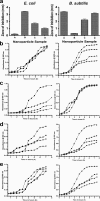Effects of engineered cerium oxide nanoparticles on bacterial growth and viability
- PMID: 20952651
- PMCID: PMC3008265
- DOI: 10.1128/AEM.00650-10
Effects of engineered cerium oxide nanoparticles on bacterial growth and viability
Abstract
Interest in engineered nanostructures has risen in recent years due to their use in energy conservation strategies and biomedicine. To ensure prudent development and use of nanomaterials, the fate and effects of such engineered structures on the environment should be understood. Interactions of nanomaterials with environmental microorganisms are inevitable, but the general consequences of such interactions remain unclear, due to a lack of standard methods for assessing such interactions. Therefore, we have initiated a multianalytical approach to understand the interactions of synthesized nanoparticles with bacterial systems. These efforts are focused initially on cerium oxide nanoparticles and model bacteria in order to evaluate characterization procedures and the possible fate of such materials in the environment. The growth and viability of the Gram-negative species Escherichia coli and Shewanella oneidensis, a metal-reducing bacterium, and the Gram-positive species Bacillus subtilis were examined relative to cerium oxide particle size, growth media, pH, and dosage. A hydrothermal synthesis approach was used to prepare cerium oxide nanoparticles of defined sizes in order to eliminate complications originating from the use of organic solvents and surfactants. Bactericidal effects were determined from MIC and CFU measurements, disk diffusion tests, and live/dead assays. For E. coli and B. subtilis, clear strain- and size-dependent inhibition was observed, whereas S. oneidensis appeared to be unaffected by the particles. Transmission electron microscopy along with microarray-based transcriptional profiling was used to understand the response mechanism of the bacteria. Use of multiple analytical approaches adds confidence to toxicity assessments, while the use of different bacterial systems highlights the potential wide-ranging effects of nanomaterial interactions in the environment.
Figures





References
-
- Adams, L. K., D. Y. Lyon, and P. J. J. Alvarez. 2006. Comparative eco-toxicity of nanoscale TiO2, SiO2, and ZnO water suspensions. Water Res. 40:3527-3532. - PubMed
-
- Auffan, M., J. Rose, J. Y. Bottero, G. V. Lowry, J. P. Jolivet, and M. R. Wiesner. 2009. Towards a definition of inorganic nanoparticles from an environmental, health and safety perspective. Nat. Nanotechnol. 4:634-641. - PubMed
-
- Barnard, A. S. 2006. Nanohazards: knowledge is our first defence. Nat. Mater. 5:245-248. - PubMed
Publication types
MeSH terms
Substances
LinkOut - more resources
Full Text Sources
Other Literature Sources
Medical
Molecular Biology Databases

